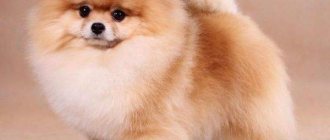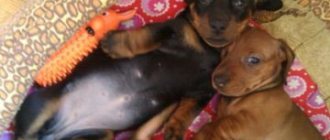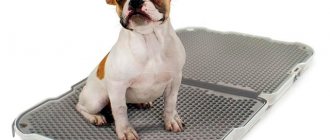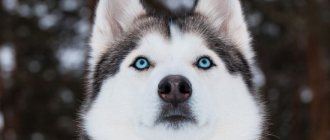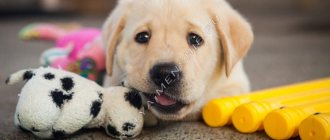The Yorkshire Terrier breed was developed at the end of the nineteenth century in England. Today it is one of the most popular decorative dogs in the world. Her miniature size, charming appearance, lively, inquisitive character attract many. It should be remembered that caring for a Yorkshire Terrier is not as easy as it seems at first glance. Yorkies require constant attention, high-quality feeding and maintenance, and regular coat care. The dog cannot tolerate loneliness, so it is recommended to get one for those who have enough time to communicate with Yorshiki.
Yorkshire Terrier Eye Care
Caring for your Yorkshire Terrier's eyes won't take much of your time.
A healthy pet should have shiny eyes, without streaks or discharge.
Unless the dog was walking in windy weather, or running on the sand, then in the morning the eyes may become a little sour. It’s okay, it’s just that the eye produces tears and thus cleans out dirt and dust.
It is enough to rinse the Yorkshire Terrier's eyes with a warm chamomile infusion or boiled water using a cotton pad.
The cause of tearing or sour eyes in a dog can be the food included in the diet.
Therefore, it is worth monitoring the pet’s health after feeding, and if you notice this fact, be sure to consult with a veterinarian or breeder. If your food is causing illness, it should be discarded. When switching a dog to food from other manufacturers, start with small portions; be sure to monitor the pet’s well-being.
Keep an eye on the fur around your Yorkshire Terrier's eyes. Sometimes it should be trimmed carefully, if the fur gets into the eyes, this can cause them to water and become inflamed. The fur around the Yorkie's eyes is rough and short and can cause eye irritation. An experienced groomer will carefully trim it, but remember, the hair grows back quickly and it can happen again.
Children are strictly prohibited from performing this procedure.
Sometimes it’s enough just to smooth the fur with wet fingers every morning. But if you notice more frequent streaks in the fur under the eyes, or tears or redness appear, contact your veterinarian immediately and under no circumstances should you treat the dog yourself.
Try not to put off going to the doctor for too long, because any advanced disease takes longer, more difficult and more expensive to treat, especially for your pet. Only after examining your Yorkie can the doctor prescribe the medicine that will help your pet.
The Yorkshire Terrier's long bangs, which fall over the eyes, like most long-haired breeds, can also cause discomfort. The fur over the eyes of a long-haired dog is tied into a ponytail on the head using an elastic band and decorated with a beautiful bow. Girls' Yorkies are decorated with a red bow on their heads, while boys usually wear a blue bow.
DRY EYES
The Yorkie is not an independent disease, but you shouldn’t start it – a decrease in eye moisture leads to dehydration. It is a consequence of various reasons: the eye was injured, thyroid problems, poor nutrition, infection. It can also appear as a side effect of medications taken by the dog.
SYMPTOMS:
- thin film on the eyeball
- small scars on the eye
- pain
- blood vessels are enlarged
Noticed discomfort in your pet; Do you have dry eye symptoms? – have your Yorkie examined at a veterinary clinic to prescribe the necessary medications. Most likely, drops will be prescribed to help restore moisture to the eye. Severe damage to the tear ducts is treated surgically.
Yorkie hygiene: care for eyes, ears, paws
Once a week you will have to brush your pet's teeth. Tartar is the cause of inflammation in a dog’s mouth. It usually occurs if there is no or insufficient solid food in the dog's food - whole carrots, apples, crackers, etc. In this case, if for some reason you do not consider them preferable, accustom your dog to brushing its teeth from childhood - use a soft toothbrush for babies, put on your finger, lubricated with a special toothpaste from a pet store (children's tooth powder is also allowed , without flavoring). Preventive examinations by a veterinarian and regular removal of tartar are necessary - you can do this procedure yourself, once you see it performed by a doctor. First of all, you will have to ensure that the dog is immobile so that the process of removing tartar is quick and painless. Holding the dog's muzzle firmly with one hand, the animal's lip is lifted with the same hand. Taking the scaler (hook for removing tartar) in your other hand and easily moving the gum away with the working part of the instrument, place it between the gum and tartar, pressing it tightly against the tooth and holding it parallel to it. Then, with a decisive movement directed vertically, remove the stone from the tooth. It is necessary to remove tartar, it brings suffering to the dog. Preventing tartar is difficult, the main thing is regular teeth cleaning. However, you can use, for example, the means recommended by dog handler A. Wolf-Talbot - regularly adding tomatoes to food or 2-3 times a week - fresh tomato juice. It is believed that this will either prevent the formation of tartar, or will thin it so much that the stone will become brittle and easy to remove. A proven preventative and treatment for gum inflammation is to massage a mixture of regular baking soda and a few drops of lemon juice into the gums once a week. Propolis also has a good effect on gums. However, always monitor your dog’s reaction (in terms of allergic manifestations) to these products. Please note that by 7 months all your pet’s teeth should have changed - if at 6-7 months the incisors are tightly arranged in 2 rows, and there are 4 canines on each jaw (instead of 2) - consult a doctor for help. As a rule, the removal operation is carried out quickly, painlessly and without consequences for the animal - on the same day, Yorkies begin to eat normally, not paying attention to the absence of several teeth. Leaving baby teeth until a later age can lead to the dog’s malocclusion, disqualification at the dog show, and bad breath.
Feeding
The portion for the Yorkshire Terrier is calculated based on the dog's weight. For an adult Yorkie, this is 20 g per 1 kg of body weight. It is very important that this portion includes healthy vitamins and microelements. The diet depends on the age of the dog. So, an adult Yorkie eats 2 times a day, adolescents from six months to a year - 3 times a day, and puppies up to six months - 4 times a day. There are three types of feeding:
- natural food (boiled meat, fish, cereals, low-fat cottage cheese);
- dry food (Royal Canin, Orijen);
- soft canned food.
The choice of food depends on the owner, who needs to think through all its pros and cons. It is recommended to consult with the breeder and veterinarian.
When feeding natural food, it is important to prepare separately for the animal.
Food from the owners' table, even if it is boiled meat or cereal, is not suitable for feeding a pet.
Ear cleaning
Regular cleaning of the ears of all dog breeds is a necessary prevention of contagious infections and ear diseases. Therefore, the ear needs to be processed next. To do this, you can use ear lotion and hygienic drops. You instill the product and rub the ear with massaging movements. After this, clean your ear with cotton swabs.
Long-haired dogs, particularly Yorkies, have hair growing in their ears, which can clog the ear canals. Hair must be removed to allow air to enter the ear canal. This reduces the risk of infection. Before cleaning your ears, you should wash your hands thoroughly, as infection or ear mites may be under your fingernails.
It is best to use a special ear powder. Gently lift the ear flap with your hand, turning it back slightly to expose the fur. A small amount of powder is distributed into the hair (be careful not to get the powder inside the ear). Massage your hair to distribute the powder evenly. The powder hairs become brittle and can be pulled out with a sharp movement, grabbing a small amount of hair in the direction of growth. Deep-growing hairs can be pulled out using special tweezers. Do not try to get the tweezers too deep inside the ear. If the powder is not available to you, you can do without it. Just massage your ear and remove them with your hands. If you do this carefully, the procedure will be completely painless.
Yorkie nail trimming
Long nails can damage a dog's paws by growing into them and scratching them, so nail trimming is a must. You need to trim your nails at least once a month. This is not an easy task; when starting it, be sure to be careful; it is very important not to cut the nail at the root, as this can hurt the nerves and injure your pet. Buy a special device - a nail clipper, which will greatly facilitate your work.
IMPORTANT! Don't forget to trim the hair on the sole of the paw, between the toes and on the pad, otherwise this hair will interfere with the dog's movement. If you find it difficult to carry out the procedure or do not have experience, it is better to trust the professionals.
Dog ear problems
Allergic ear scabies. Allergies can cause skin redness and itching. The dog constantly scratches its ears, damaging the skin (damaged, scratched ears are very susceptible to pathogenic bacteria). In this case, you need to contact your veterinarian to determine the cause of the allergy.
Ear Mite. An animal infected with ear mites shakes its head and constantly scratches its ears. Scabies is caused by the movements of microscopic mites that live in the ear plaque. To determine the presence of mites, take a small amount of ear plaque, place it on paper and examine it under a bright lamp. Tiny white spots that seem to move are ear mites. To rid an animal of ear mites, you need to know their life cycle. The insecticide kills only adult ticks. Ticks mature in 10 days, and the cycle is constantly repeated. Treat ears for 7 days, then break for 10 days, and treat again for 7 days. Ear mites are highly contagious, so preventative treatment is necessary for all animals in the house.
Ear Hematoma. Blood vessels in the ear burst, causing all or part of the ear to swell. A hematoma usually forms when an infection gets into a scratched or wounded ear. Contact your veterinarian for treatment of the hematoma.
>How to properly clean your Yorkie's ears
How to bleach a dog's fur
Unlike colored hair containing melanin, white porous hair gets dirty faster. Therefore, white wool requires more careful care. Lack of proper care for the white coat of dogs very quickly leads to the fact that the snow-white coat becomes yellow.
Even regular removal of dirt will not get rid of yellowness and tarnishing. There are many reasons why white fur turns yellow or red. The most common of them are low-quality food, proteins contained in saliva, tears and urine, and cosmetics.
How often do Yorkshire Terriers' ears get cleaned?
Hair removal from the ear canal should be done once every 2-3 months.
It is necessary to clean the ears using care products after each bath (pets of this breed are bathed once every 1-3 months, depending on the length and dryness of the coat).
You should also monitor your pet’s condition and if any discharge or an unpleasant odor appears, immediately contact a veterinarian.
So, in what cases should you wash your eyes? • For prevention (slight red-brown crusts in the inner corner of the eye, slight tearing); • Before using medications; • If irritating chemicals come into contact with the eyes; • NOT FOR TREATMENT! How to wash your eyes? Step 0. Prepare inventory. Select and prepare an eye wash solution from the list below. Prepare sterile gauze pads or clean cotton pads. Step 1. Catch and record the animal. If you have a small, nimble dog, wrap it in a towel or put it in a narrow carrier with one head sticking out of it. A large or calm dog can be placed in the bathtub or sink. Step 2. Wash your hands thoroughly with soap! Step 3. Soak the crusts. Wet a napkin in the prepared solution and soak closed eyelids and the contaminated area around them for several minutes. Then painlessly and carefully remove the soaked crusts from the wool. If after this the eye does not open and is still closed, do not try to open it yourself. Contact your ophthalmologist! Step 4. Rinse the eye. It is more convenient to rinse the eye, or rather the cornea and conjunctiva, using a sterile 20 ml syringe with the needle removed, a clean syringe, or a napkin generously soaked in the solution. Draw up the rinsing solution. Using the thumb and index finger of your left hand, spread your eyelids (call your neighbors to hold your nimble head). It is better to apply the solution to the upper outer corner, in which case it will wash the entire surface of the cornea and conjunctival sac. When using a generously moistened cloth, the latter can be used to gently wipe the conjunctiva. If during rinsing you notice foreign, indelible particles lying on the surface of the eye or in the folds of the conjunctiva, do not touch them and do not try to remove them yourself, immediately run to the doctor! Step 5. Complete the procedure. Finally wipe the eye area, eyelids and fur with a dry cloth in the direction from the outer to the inner corner of the eye (from ear to nose). What to do if chemical irritants get into your eye? Step 1 and the only one. Save the eye. If an emergency occurs with chemicals getting into your dog or cat’s eyes, immediately grab the animal and take it to the bathroom under a warm (25°C) stream of running water. For a long time (15-20 minutes), rinse the open eye generously! If there is no running water, a store with drinking water, or even a milk bottle nearby, it is possible to reduce the severity of eye damage by drying the eyeball with a piece of cotton wool or other highly absorbent fabric. To do this, press a piece of tissue against the area of the tear pool (the pocket that forms when the lower eyelid is pulled back). If you decide to prescribe antibiotic-containing eye medications on your own (and especially potent drugs from the groups of cephalosporins, macrolides, aminoglycosides), it is better to abandon this idea and call a veterinarian ophthalmologist. In cases where eye drops were prescribed by a doctor, instillation is carried out according to the same principle as rinsing. Place the index finger of your left hand on the upper eyelid, and lightly pull down the lower eyelid with your thumb. Use a cleanly washed pipette or syringe (when the bottle does not come with a special dropper), instill 1-2 drops. Eye ointments (eg 1% tetracycline eye ointment) are applied in a similar manner. The ointment is placed 0.5-1 cm behind the lower eyelid, into a neatly opened eye. After applying any medication (drops, gels, ointments), it is necessary to carefully close the eyelids and lightly massage the eye to allow the medication to be evenly distributed over the surface of the cornea and conjunctival sac. It is important to maintain a time interval between eye procedures. It is possible to apply anything to the eyes after rinsing after 5-10 minutes, and the interval between medications should be at least 15 minutes. What solutions should I use to wash my eyes? Doctors divide eye wash solutions into two groups - special commercial eye wash solutions and solutions that are simply suitable for this purpose. 1. Special solutions for washing the eyes: • Ofto-Lavas from Vetoquinol • Eye lotion “Chamomile”, • Beaphar oftal augenplege • 8 in 1 Tear stain remover EJ, • I Voss 2. Solutions suitable for washing • Physiological, 0, 9% sodium chloride solution, sterile; • Furacilin solution 1:5000 (in a pharmacy to order without a prescription); • 2% boric acid solution; • Chlorhexidine 0.01% (it is possible to prepare it yourself from a 0.05% solution of chlorhexidine; for this, 4 ml (0.05% solution) must be taken into a 20 ml syringe and diluted to 20 ml with physiological sodium chloride solution); • Potassium permanganate solution 1:5000 (this is slightly pink); • Chamomile decoction (Brew 1 bag of dry chamomile in a glass of boiling water, or 1 tablespoon of chamomile flowers in crumbly form, pour 200 ml of boiling water. Cool before use!). • Spilled tea (that is, the one that remained unfinished from yesterday evening); • Ordinary running water - from the tap, preferably boiled water - from a kettle; It is better to use all solutions slightly warm, or at room temperature. Ophthalmologist Alexander Andreevich Konstantinovsky, M.G. Sretenskaya Veterinary_________________
Why do my dog's eyes fester?
Discharge of pus from the eyes can occur for various reasons. A qualified and experienced veterinarian must determine the source of a possible problem. If your dog's eyes are festering, what could be the possible causes? The main causes of profuse lacrimation and purulent discharge in the eyes are most often:
- irritation (reaction to contact with household chemicals, aggressive chemicals, smoke, sand, etc.);
- microtrauma (twigs, blades of grass, specks or other foreign bodies getting into one eye while walking or at home);
- allergic reaction (the dog may be allergic to food, pollen, medications);
- parasites (if the eyes are festered, this can be caused by fleas, worms, skin mites and other parasitic creatures);
- fungi and bacteria (general and local damage to the dog’s body by an infection that can only be detected through laboratory testing);
- viral disease (eyes fester due to a dangerous virus - rabies, enteritis, plague, etc.);
- conjunctivitis in dogs;
- chronic diseases (suppuration of the tear ducts due to “senile” diseases, weakened immunity and diseases of internal organs).
Many dog breeders pay little attention to lacrimation and purulent discharge, believing that everything will go away on its own. But, if suppuration due to allergies, microtrauma or irritation does not pose a particular danger, then the formation of pus due to a viral or chronic disease can lead to adverse consequences, including the death of the animal.
Therefore, it is so important to promptly show the sick pet to a veterinarian in case of purulent discharge.
What is important for the owner to know
Yorkies are very fragile creatures. On average, this dog breed lives from 12 to 14 years. An adult animal should weigh no more than 3170 grams.
The Yorkshire Terrier is very friendly and can quickly form friendships with people or animals. He is devoted to his owner, an attentive listener. It has long been known that Yorkies have a positive effect on the psyche.
This breed of dog does not shed and does not have a specific odor.
If you buy a Yorkshire Terrier puppy without the help of a specialist, you need to pay attention to the following features:
- The “calling card” of a real Yorkshire Terrier is its brand.
- The legs should be straight and the back should be level.
- The wool and skin are clean; if the wool looks like cotton wool, you will have to suffer with it.
- The eyes, nose and ears should not be damaged or inflamed.
- There should be six teeth below and six below, a scissor bite.
How often to walk
A Yorkie puppy should be taught to walk gradually, first he is taken outside in his arms and walked for a short time, after a while you can start carrying him in a bag. And only when he gets used to it, you can put the puppy on the grass for a while if the weather is good outside.
You should only walk with this curious dog using a roulette wheel. A walk of about an hour a day is enough to satisfy your Yorkie's need for activity.
Although Yorkies have long hair, they do not provide warmth due to the lack of undercoat. Therefore, it is better to dress your dog in special overalls and shoes for walks.
What physical activity does a dog need?
Your Yorkie should receive some physical activity every day. Games are suitable for this, so you need to make sure that the dog plays and runs as often as possible.
If you don't let it discharge, your Yorkie will start misbehaving at home: tearing wallpaper, chewing things and doing all sorts of mischief.
What troubles can happen to a Yorkshire Terrier?
Yorkies are brave, curious and fearless. Recklessly brave puppies, chasing something, can jump out onto the road or fall under the feet of a person or the wheels of a stroller.
Therefore, in order to avoid troubles, it is imperative to control their movement.
It is imperative to teach the puppy basic commands, as without them you can lose the puppy. They are easy to train, but this requires a strong owner, as these dogs are very ambitious.
Nails
The Yorkshire Terrier also needs to have its nails trimmed regularly with a special tool (scissors should not be used). If the dog often runs on hard surfaces, these procedures may be less frequent, as the nails wear off on the surface. It is important to avoid overgrown claws because they can cause problems walking or even deformed toes.
How to care for a newly purchased puppy
Even before the puppy arrives, you need to take care of the necessary care items and prepare the place. In a new home, the terrier may be frightened by the new environment, but gradually he will begin to get used to it and master the territory.
What to buy for a puppy
It is better to buy all products for the maintenance and care of the Yorkshire Terrier in pet stores or at large exhibitions.
For York you will need:
- enclosure (to create a cozy and safe place in the puppy’s home);
- bed;
- carrying bag;
- collar with leash and tape measure;
- bowls, at least two pieces;
- feeder and drinking bowl (necessarily heavy, ceramic or earthenware);
- latex and edible toys made from veins (bones, balls, squeakers);
- specialized cosmetics (shampoos, balms, sprays);
- Terry towel;
- combs of several types: metal with a comfortable handle and frequent rounded teeth; massage brushes;
- papillots with elastic bands;
- small scissors with rounded ends, which are convenient for trimming the hair on the ears and between the toes;
- nail clippers or nail clippers;
- file for sharpening claws;
- various clothes;
- bows, hairpins and various accessories for creating hairstyles
Prepare your apartment for the arrival of a dog
For the puppy, you need to secure the quietest place in the house. Do not give it a place where drafts are possible. You cannot assign the puppy a place near the radiator, in the corridor where people often walk.
Remove all small toys and things from the house that an inquisitive dog might chew or swallow. It is better to purchase a special playpen, the dog will be safe in it, but do not put it in a dark corner. Give your Yorkie a bed to sleep on.
How to prepare a place where the dog will rest?
You can sew a puppy bed yourself by filling it with padding polyester or furniture foam rubber. Removable covers are a must. Specialized stores sell sun loungers with sides or in the shape of a house. Dogs feel more protected on them.
A basket for a Yorkie's sleeping place will not be suitable, since he will definitely want to chew on it - “to taste it.”
How to train to the tray
It’s not difficult to train a Yorkie to sit on a tray, but at first you will have to suffer a little. Be patient, if you scold and punish him, you can upset the dog’s psyche.
Little Yorkies relieve themselves after eating and sleeping. This is the time to plant them. Stand in front of him until he empties. After this, be sure to praise him. Soon the dog will learn to cope with this matter on its own.
And if your pet continues to misbehave at home, then read our detailed recommendations on how to wean him off it.
Creating conditions for the dog
When a puppy arrives, it is important to provide him with comfortable conditions for development. A small Yorkie needs good nutrition, active exercise and proper rest. Creating a place to rest is an important stage in preparing comfortable conditions for the dog. It is necessary to create a “shelter” for the puppy to rest, even from the owners. A place to rest can be presented in the following form:
- soft bedding with low sides and sufficient size for the dog to crawl into it and stretch its paws;
- bedding made of natural material with replaceable covers for easy washing;
- house - booth;
- a thick and soft blanket in a secluded corner of the apartment.
Recommendations for choosing a place to stay:
- the litter should not be in a draft or passage;
- the resting place should have a good view of the entire apartment and the owners;
- There should be no objects dangerous for the puppy (wires, dangerous plants) near the resting place;
- the place should be bright;
- the litter must be clean and dry;
- the resting place should be located away from direct heat sources (batteries, radiators, sun rays);
Even if the dog sleeps in the bed with you, it should have its own place.
To feed the puppy, you should choose a place where the animal will not be disturbed. In city apartments this is usually the kitchen or bathroom, as they are the easiest to keep clean. In addition to the food bowl, feeding requires:
- a bowl for water (preferably ceramic);
- adjustable stand for the bowl (to avoid neck strain and spine problems in the future).
A bowl of filtered water should always be available to the dog, and the water in it should be changed at least once a day.
Yorkshire Terriers do not always require walking. They can be trained to go to the toilet in a litter box at home. Regarding the toilet space, the following requirements must be met:
- the tray should not be in the aisle;
- It is better to place a disposable diaper in the tray;
- for male dogs, a tray with a post is required;
- the toilet should always be accessible to the dog;
- the toilet area should be easy to clean;
The presence of a litter box in the house does not mean that walks should be canceled altogether.
Yorkshire Terriers love to walk; fresh air and good weather are the key to a happy and healthy pet.
Basic rules for keeping a Yorkie
To prevent diseases, do not forget to examine the terrier daily; if there is any abnormality, the puppy must be shown to a veterinarian.
A normal, standard, healthy Yorkshire Terrier typically weighs between 2 and 3 kg. The temperature, which is measured through the anus, should be 38-39 degrees.
What are the problems and diseases?
In the process of breeding a Yorkie, the following diseases are most often noticed:
- Dermatitis, alopecia and other skin diseases. With dermatitis, tumors and fever appear. Alopecia causes patchy hair loss, usually on the scalp.
- Eye diseases such as cataracts and glaucoma. They can appear due to improper care, after which the dog’s eyes become cloudy.
- Displacement of the joints of the limbs. Patella dislocations. They are usually congenital.
- Diseases of the joints of the limbs, fractures, etc. Because of them, the dog begins to limp.
- Kidney disease, with frequent urination and thirst. The dog is losing weight, although her appetite remains good.
- Allergy.
- Non-closure of the fontanel. By the time the dog is one year old, it should be closed.
- Spasm of the pharynx, which makes breathing difficult, leading to suffocation.
- Hernia.
When to get vaccinated?
Vaccinations will help keep your pet healthy. The first vaccination is given at 6 weeks, then repeated after two or four weeks. The next vaccination is scheduled for the year when all the teeth are replaced.
Then one vaccination is given per year. Two weeks before vaccination, it is necessary to carry out procedures to expel worms.
Grooming
All Yorkies have long, beautiful hair that requires constant care. It is necessary to comb the fur. You can give your dog a model haircut, but most owners like to do their pet’s hair themselves.
Vitamins and vaccinations
Vaccinations are mandatory. They protect the animal from viruses, rabies and distemper. Vaccination of a puppy occurs as follows:
- The first vaccination is given at the age of 8 - 9 weeks;
- the second vaccination is given 2 weeks after the first;
- the third vaccination is done after changing teeth;
- After vaccination, puppies up to 8 months are placed in a two-week quarantine.
As for vitamins and amino acids, most are contained in a properly selected diet. If your diet does not contain them, then the easiest way is to get a set of useful elements in the form of food additives. The most common vitamin complexes are:
- "Calcide"
- "Excel";
- Omega - 6 and Omega - 3.
Before use, consult a veterinarian. You should not prescribe vitamins yourself.


